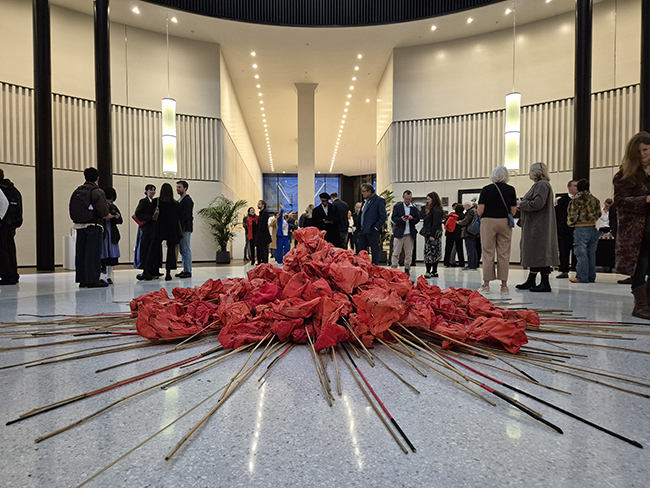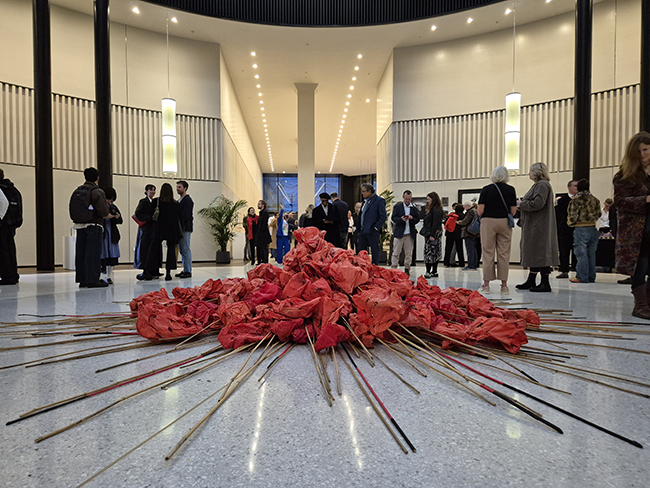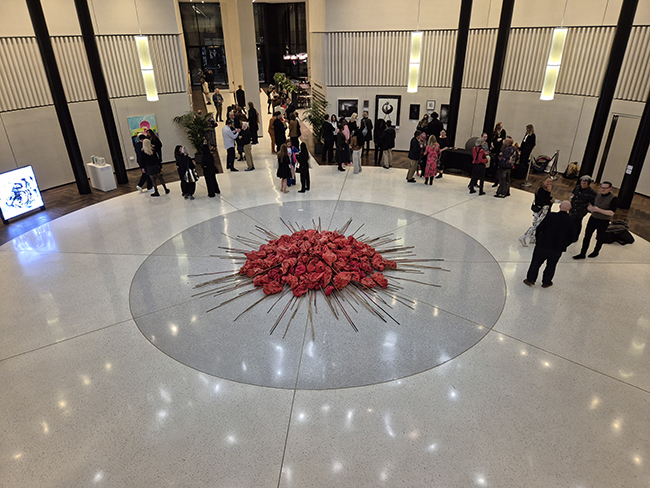Bea Last, a Scottish artist, weaves a narrative of raw beauty and profound meaning through her unique creative practice. Currently based in the picturesque landscapes of Scotland, Last’s work is a testament to her dedication to process and her ability to transform recycled, repurposed, found, salvaged, or gifted materials into what she calls sculptural drawing. Her creations, abstract in form yet emotionally charged, open conversations about what it means to exist in a world shaped by conflict, climate anxiety, and resilience. Each piece challenges viewers to confront the fragility and endurance of the human condition. Her art moves quietly but with purpose—it is less about visual comfort and more about awareness, empathy, and reconstruction.
Images of The Red Bags – Sculptural Drawings Installation

At first glance, Images of The Red Bags appears simple: a sea of crimson forms suspended in space. But spend time with it, and the work begins to breathe. Composed of 700 handcrafted sculptural bags made from recycled and repurposed materials—bamboo, fabric, and even fragments marked by bullet holes—this installation is less an object and more a conversation between destruction and renewal.
Presented at VAO 2025 (Visual Arts Open) Finalist Exhibition at The Minster, Mincing Lane in London, Last’s installation takes on an almost sacred presence. The bags, each made by hand, recall both fragility and survival. They hang or cluster like organic growths, delicate but deliberate. The repetition is hypnotic. Together they resemble a mass migration, a field of vessels carrying invisible histories.
The color red dominates, and it is impossible to ignore. Red can mean life, blood, or danger—it is both wound and warning. In The Red Bags, that tension is constant. Some pieces appear torn or punctured, the bullet holes cutting through their surfaces like small moments of violence. Others seem to mend themselves through their form, as if the act of being made was already an act of healing.

Last’s process is deeply physical. She gathers materials from what others discard—bamboo fragments, torn cloth, wires, and everyday remnants of the world’s consumption. Her approach is not about reusing for the sake of sustainability alone; it’s about redemption. The materials hold stories. In her hands, what was once broken or forgotten becomes part of a collective body that speaks about endurance and the need for repair.
In the gallery, the installation occupies space like memory itself—dense, suspended, never static. Viewers move around it as though navigating a landscape of quiet unease. There’s beauty, but it’s not the polished kind. It’s raw, aching, alive. The bullet holes, especially, stop you. They remind you that violence is not abstract—it leaves marks on bodies, places, and objects. Last’s work makes these marks visible again, not to shock but to invite reflection on how easily destruction becomes invisible in daily life.
The title, Images of The Red Bags, suggests both documentation and metaphor. Each bag is an image, a unit of meaning, but collectively they form something larger—an archive of trauma, care, and transformation. They evoke refugees’ bags, medical kits, or even reliquaries. You can almost imagine them containing whispers, the residue of stories carried across borders or generations.
What gives the work its emotional charge is how it bridges personal and global concerns. On one hand, the installation speaks to humanitarian crises—the displacement of people, the scars of war, the waste we leave behind. On the other, it reflects Last’s own inner landscape as an artist who finds coherence through making. Every repetition, every knot or stitch, becomes a meditative act. Through these gestures, she reshapes chaos into rhythm, grief into form.
There’s something deeply humane in the way she uses labor and patience to confront overwhelming subjects. In The Red Bags, she doesn’t tell us what to think; she gives us space to feel. The installation doesn’t deliver answers—it offers presence. It reminds us that repair is possible, even if incomplete. That art can hold pain and beauty in the same breath.
Standing before the work, the air feels heavier, quieter. You sense time—the time it took to make each piece, the histories implied within the materials, and the collective moment we share with them. Bea Last’s sculptural drawings are not static sculptures. They are moments of empathy suspended in space. Through them, she shows that art can be both protest and prayer, both fragile and enduring—an act of rebuilding, one red bag at a time.

